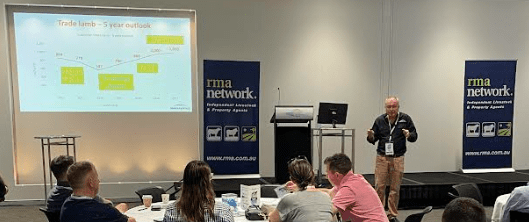
Simon Quilty presents to the 2024 RMA Network conference
AUSTRALIAN cattle and lamb producers can expect a lift in prices with falling beef supplies as the global herd enters a rebuild phase over the next few years, Global AgriTrends analyst Simon Quilty told delegates at the recent RMA Network conference.
At the conference, Mr Quilty said sheep meat prices, in particular lamb values, will move with global beef prices – and were “joined at the hip.”
He said cattle herds in Australia, North America and South American countries were simultaneously about to enter rebuild phases for the first time in his memory.
“The largest supply countries around the world are in synch and it has never happened before, I don’t believe, which points to a critical shortness in global supply next year and the year after and probably the year after that.”
He said there have been record prices for beef in America in recent weeks. Next year North America could have its lowest cattle kill in history and the herd is at a 73-year low in the herd. Rain over last year, rising calf prices and the female kill rate all pointed to the US herd being about to enter a rebuild phase, he said.
“But it’s just not a cattle story, it’s about mutton and lamb as well.
“We’ve seen record production in lamb kill in Australia, it’s sitting at about 167,000 metric tonnes at the moment,” Mr Quilty.
“The mutton kill is also up, but not at record level, but it’s been significant … and the flock is liquidating.
“We’re on track to kill about 9.5 million ewes this year.”
National flock set to fall dramatically
Mr Quilty said Australia has had two extraordinary years of mutton kills, but he was expecting this to almost halve over the next two years to about 4.8 million.
“And there is no doubt in my mind after giving talks across the eastern seaboard that people are exiting the business in the sheep game.
“It’s happening in South Australia, it’s happening in WA and it’s happening across New South Wales in particular, people are getting out,” he said.
“What does that mean? Those that stay will reap the benefits, because they will be substantial.”
Mr Quilty sees the overall flock size falling dramatically in 2024 and over the next two years.
The price of lamb is already at 810-820c/kg and “850c/kg for August is an easy get,” he said.
He said the lamb sector is the perfect supply-demand model, with prices falling when supply increases and vice versa.
“With the lamb slaughter increase last year to almost 25 million, prices went to 587cts and actually fell far more than they should have for the lack of capacity.”
Next year Mr Quilty is expecting the lamb kill to get to about 17 million in 2026/27 and prices to get to 1000c/kg and 1050c/kg in those years respectively.
“Lack of supply.”
Consumers, processing labour and the Aussie dollar
Mr Quilty global consumers can afford to pay higher beef and lamb prices.
“They’re already affording it, what’s happening is, when you see the retail price — well why would you drop retail prices in America today, because you know nothing is coming down the pipeline, you’re in for three years of unbelievably tight supply?
“They will hold them and go higher if they can, the thing that moves is wholesale prices,” he said.
“My point to you is that consumer is already paying for it today, you just don’t know it.”
Mr Quilty said Australian lamb supply overwhelmed the global market last year and crashed prices, but they are improving.
“With the increase in protein prices in America (beef, chicken, pork), lamb will be able to compete.”
In the long-term, Mr Quilty said one concern was consumer wages were not keeping up with costs of living, which would mean a delay – perhaps another year – before the full benefit of higher wages was seen.
But Mr Quilty said “the worst is over” for lamb producers and global prices have bottomed. Lamb demand is improving around the world, with wholesale prices increasing in the US and other major markets, but Australia was still very reliant on China with prices lower.
However, Mr Quilty had some lamb industry concerns. He said light lambs have been problematic for the Australian industry, including in parts of New South Wales and South Australia where the season to finish lambs had been getting shorter. Victoria today was killing 2.4 times NSW’s lamb slaughter figures indicating the southern state’s growing conditions presented less risk for finishing lambs, he said.
In 2028, Mr Quilty is forecasting lamb prices to drop from 1050c/kg to under 700c/kg, as sheep producers respond by lifting supplies, potentially creating labour issues in the processing sector.
On the impact of currency movements on producers’ prices, Mr Quilty said in a tight supply market they will get the benefit of a falling Australian dollar (against the USD), “because every exporter, every trader hands back that win on the Aussie dollar because they are struggling to get output because they are trying to maintain labour in their meat works.”
But in oversupply situations, processors had no incentive to pass on the benefit of a falling Aussie dollar, to sheep and beef producers, he said.

HAVE YOUR SAY